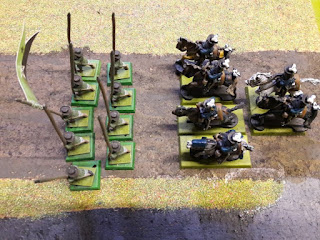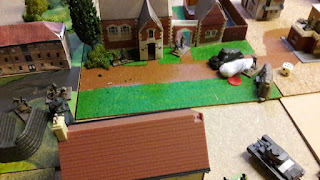Continuing move 2.1...
The clash at Farren Mill brings the two faction leaders face to face on the field for the first time. Marching from the north to reach the small town first are Kirby's Parliamentarian force combining the Stanton Brimard First and Second foot with his own Raffham Scout Cavalry and Sir Lyall Wetherick's hurriedly raised Farren Mill Reserve. Short on horse, Kirby takes up a defensive position around the mill digging in light cannon.
The Earl of Sedgewater, Sir Charles Langley arrives from the south, the road swinging west so his forces approach from the east of Farren Mill. He has two units of foot from Brindley plus cavalry in the form of the First Stourwold horse and the Penfield Light Horse. He advances in standard formation with one cavalry unit on each flank.
Neither force is very large so this promises to be a swift skirmish and one that will decide initial ownership of Farren Mill with its useful position on the road into the Vale of Wells. Additionally, victory for Langley would grant him access to other potential towns. Victory for Kirby would free Lord Stirling to move on the neutral town of Turnwall and possibly on to Stanport.
Kirby sends his Raffham Scout Cavalry into the town to seek out Langley's forces. At the same time, Langley orders Sir Miles Wolfden to take the Penfield Light Horse and ensure that the churchyard is clear of any artillery or other firing position and then proceed down the lane to the town.
The Stourwold Horse, meanwhile, cross the river and enter the town, encountering the Raffham Scout Horse whereupon a swift skirmish occurs.
In the centre of the field, the two Brindley foot units approach the position now held by the Stanton Brimard 1st foot.
Realising that the Raffham Scout Cavalry were no match for a full cavalry unit, the Raffham retreated, drawing the Stourwold Cavalry in pursuit. This allowed the artillery to fire on the Stourwold but the shots went wide. The Farren Mill Reserve then interposed themselves forcing the Stourwold horse to stop and melee while the Raffham Scout horse halted and rallied.
The foot units moved in, firing muskets with little effect. The Stanton Brimard 2nd foot swung about and approached from the north while the 1st foot held position on the lane, using the trees and slopes as cover. The Penfield Light Horse having entered the churchyard unopposed, swung around the church and entered the lane.
This forced Langley to order the Brindley 1st Foot to turn and engage the approaching Stanton Brimard 2nd, thus losing his temporary advantage in numbers in the centre. A long struggle then ensued between the units engaged, even when the Penfield Horse rode by, raking the Stanton Brimard 1st with pistol and blunderbuss fire.
Slowly, as men tired and wounds were taken, the Stanton Brimard 1st started to push the Brindley 2nd back. The Stanton Brimard 2nd did not fare as well, however, as they were losing the pushing and shoving match with the Brindley 1st. The Brindley 2nd retreated into the town.
At the same time, the Farren Mill Reserve, which had been losing ground against the Stourwold Horse but had held, because Kirby was present to rally them, now broke and fled the field altogether. The Stourwold Horse went after them and also left the field. By this time, the Penfield Light had arrived and halted to get into good order. They now clashed with the Raffham Scout horse which was protecting the artillery. Once again, the guns failed to make any impression on the advancing Penfield unit which took some minor wounds from grapeshot but were not affected.
In the town, General Langley, mastermind of the 1st Civil War tried to rally the Brindley 2nd but his words seemed to cause the already panicked unit to lose it's way altogether and the men broke and ran for the road out of the town. Langley, seeing he would be exposed by this event, withdrew from the field.
A similar scenario was being enacted just west of this where the Raffham horse were pushed back and General Kirby retreated with the remainder of that unit pursued for a short distance by the Penfield Light.
The Brindley 1st had succeeded in forcing the Stanton Brimard 2nd to break and retreat but when Sir Clive Camberwell, veteran of the first war rallied the Stanton Brimard troop, it turned to face the Brindley 1st again.
Seeing that they had no support and that their commander was leaving the fray, Major William Clayton ordered the Brindley 1st to back off and they then marched off the field in good order. The Stanton Brimard 2nd remained near the church, glad not to have to fight on. They had taken losses and most of the men were desperately tired.
The battle was inconclusive but Farren Mill remained in Parliamentary Democrat hands. Both generals retired to consider their next move. Sir Lyall Wetherick, having fled with his reserves, eventually turned up at Raffham with little more than his horse and weapons.
















































